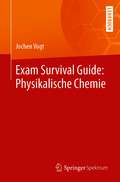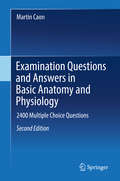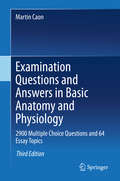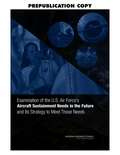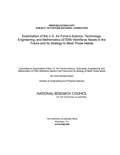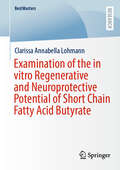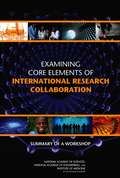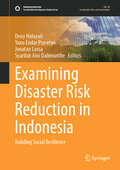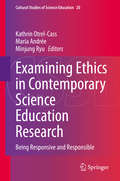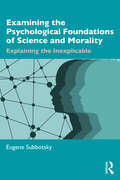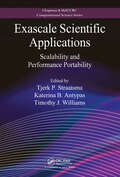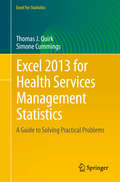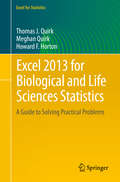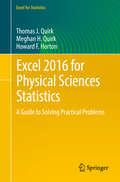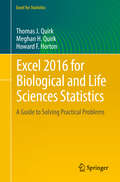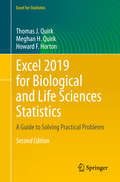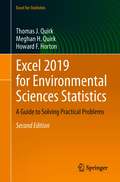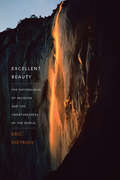- Table View
- List View
Exam Survival Guide: Physikalische Chemie
by Jochen VogtDieses Buch leitet Sie zum selbstständigen Lösen anspruchsvoller Probleme an. Es ist optimal geeignet für Studierende zur Prüfungsvorbereitung und zur Vertiefung des Lehrstoffs in physikalischer Chemie. Schärfen Sie Ihre Fähigkeiten im Problemlösen in einem breiten Aufgabenspektrum von stöchiometrischem Rechnen bis zur Molekülspektroskopie. Jedes Kapitel wird mit einem Überblick über Grundlagenwissen eingeleitet. Die Lösungswege werden ausführlich besprochen. Neben inhaltlichen Bezügen zwischen den Themengebieten wird akzentuiert auf methodische Gemeinsamkeiten der Lösungswege hingewiesen. Der umfangreiche mathematische Anhang ist passgenau zugeschnitten auf physikalisch-chemische Rechenmethoden und macht das Buch zu einem praktischen Begleiter durchs Studium. Darüberhinaus ist das Buch ein Ideengeber für Dozenten zur Vorbereitung von Lehrveranstaltungen.
Examination Questions and Answers in Basic Anatomy and Physiology: 2000 Multiple Choice Questions
by Martin CaonThis second edition provides 2400 multiple choice questions on human anatomy and physiology, and some physical science, separated into 40 categories. The answer to each question is accompanied by an explanation. Each category has an introduction to set the scene for the questions to come. However, not all possible information is provided within these Introductions, so an Anatomy and Physiology textbook is an indispensable aid to understanding the answers. The questions have been used in end-of-semester examinations for undergraduate anatomy and physiology courses and as such reflect the focus of these particular courses and are pitched at this level to challenge students that are beginning their training in anatomy and physiology.The question and answer combinations are intended for use by teachers, to select questions for their next examinations, and by students, when studying for an upcoming test. Students enrolled in the courses for which these questions were written include nursing, midwifery, paramedic, physiotherapy, occupational therapy, nutrition and dietetics, health sciences, exercise science, and students taking an anatomy and physiology course as an elective.
Examination Questions and Answers in Basic Anatomy and Physiology: 2900 Multiple Choice Questions and 64 Essay Topics
by Martin CaonThis third edition provides 2900 multiple choice questions on human anatomy and physiology, and some biophysical science, separated into 20 chapters and 68 categories. In addition, there are 64 essay topics. The answer to each question is accompanied by an explanation. Each chapter has an introduction to set the scene for the questions to come. However, not all possible information is provided within these Introductions, so an Anatomy and Physiology textbook is an indispensable aid to understanding the answers. The textbook offers a more holistic approach to the subjects of anatomy and physiology by also including biomechanics, biophysics and biochemistry. The questions have been used in end-of-semester examinations for undergraduate anatomy and physiology courses, and as such, reflect the focus of these particular courses and are pitched at this level to challenge students that are beginning their training in anatomy and physiology. The question and answer combinations are intended for use by teachers, to select questions for their next examinations, and by students, when studying for an upcoming test. Students enrolled in the courses for which these questions were written include nursing, midwifery, paramedic, physiotherapy, occupational therapy, nutrition and dietetics, health sciences, exercise science, and students taking an anatomy and physiology course as an elective.
Examination of the U.S. Air Force's Aircraft Sustainment Needs in the Future and Its Strategy to Meet Those Needs
by Air Force Studies BoardThe ability of the United States Air Force (USAF) to keep its aircraft operating at an acceptable operational tempo, in wartime and in peacetime, has been important to the Air Force since its inception. This is a much larger issue for the Air Force today, having effectively been at war for 20 years, with its aircraft becoming increasingly more expensive to operate and maintain and with military budgets certain to further decrease. The enormously complex Air Force weapon system sustainment enterprise is currently constrained on many sides by laws, policies, regulations and procedures, relationships, and organizational issues emanating from Congress, the Department of Defense (DoD), and the Air Force itself. Against the back-drop of these stark realities, the Air Force requested the National Research Council (NRC) of the National Academies, under the auspices of the Air Force Studies Board to conduct and in-depth assessment of current and future Air Force weapon system sustainment initiatives and recommended future courses of action for consideration by the Air Force. Examination of the U. S. Air Force's Aircraft Sustainment Needs in the Future and Its Strategy to Meet Those Needs addresses the following topics: Assess current sustainment investments, infrastructure, and processes for adequacy in sustaining aging legacy systems and their support equipment. Determine if any modifications in policy are required and, if so, identify them and make recommendations for changes in Air Force regulations, policies, and strategies to accomplish the sustainment goals of the Air Force. Determine if any modifications in technology efforts are required and, if so, identify them and make recommendations regarding the technology efforts that should be pursued because they could make positive impacts on the sustainment of the current and future systems and equipment of the Air Force. Determine if the Air Logistics Centers have the necessary resources (funding, manpower, skill sets, and technologies) and are equipped and organized to sustain legacy systems and equipment and the Air Force of tomorrow. Identify and make recommendations regarding incorporating sustainability into future aircraft designs.
Examination of the U.S. Air Force's Science, Technology, Engineering, and Mathematics (STEM) Workforce Needs in the Future and its Strategy to Meet Those Needs
by National Research Council of the National AcademiesThe Air Force requires technical skills and expertise across the entire range of activities and processes associated with the development, fielding, and employment of air, space, and cyber operational capabilities. The growing complexity of both traditional and emerging missions is placing new demands on education, training, career development, system acquisition, platform sustainment, and development of operational systems. While in the past the Air Force's technologically intensive mission has been highly attractive to individuals educated in science, technology, engineering, and mathematics (STEM) disciplines, force reductions, ongoing military operations, and budget pressures are creating new challenges for attracting and managing personnel with the needed technical skills. Assessments of recent development and acquisition process failures have identified a loss of technical competence within the Air Force (that is, in house or organic competence, as opposed to contractor support) as an underlying problem. These challenges come at a time of increased competition for technical graduates who are U.S. citizens, an aging industry and government workforce, and consolidations of the industrial base that supports military systems. In response to a request from the Deputy Assistant Secretary of the Air Force for Science, Technology, and Engineering, the National Research Council conducted five fact-finding meetings at which senior Air Force commanders in the science and engineering, acquisition, test, operations, and logistics domains provided assessments of the adequacy of the current workforce in terms of quality and quantity.
Examination of the in vitro Regenerative and Neuroprotective Potential of Short Chain Fatty Acid Butyrate (BestMasters)
by Clarissa Annabella LohmannImmune-mediated polyneuropathies stem from dysregulation of the immune system and affect a wide range of the population. Inflammatory diseases such as chronic inflammatory demyelinating polyneuropathy (CIDP) and Guillain-Barré syndrome (GBS) are the most common acute and chronic treatable immune-mediated polyneuropathies. The immune system mediates primarily demyelination but also neuronal degeneration through oxidative stress. As a result, patients suffer from hyporeflexia or areflexia accompanied with sensory and motor deficits as the disease progresses, which can lead to hospitalization and death. Over the years, nutrition and intestinal metabolism have become more relevant for the regulation of the immune system. In particular, short chain fatty acids (SCFA) have become the focus of attention. Currently, the best-studied SCFA is butyrate, produced by bacteria in the intestine along with propionate and acetate. Butyrate has already achieved promising results in areas such as oncology and immunology. Now, in the context of this master thesis, the question arises of the neuroprotective and neuroregenerative abilities of butyrate under oxidative stress.
Examining Core Elements of International Research Collaboration: Summary of a Workshop
by The National Academy of SciencesThe globalization of science, engineering, and medical research is proceeding rapidly. The globalization of research has important implications for the U. S. research enterprise, for the U. S. government agencies, academic institutions, and companies that support and perform research, and for the world at large. As science and technology capabilities grow around the world, U. S. -based organizations are finding that international collaborations and partnerships provide unique opportunities to enhance research and training. At the same time, significant obstacles exist to smooth collaboration across national borders. Enhancing international collaboration requires recognition of differences in culture, legitimate national security needs, and critical needs in education and training. In response to these trends, the Government-University-Industry Research Roundtable (GUIRR) launched a Working Group on International Research Collaborations (I-Group) in 2008, following its meeting on New Partnerships on a Global Platform that June. As part of I-Group's continuing effort, a workshop on Examining Core Elements of International Research Collaboration was held July 26-27, 2010 in Washington, DC. One primary goal of the workshop is to better understand the risks involved in international research collaboration for organizations and individual participants, and the mechanisms that can be used to manage those risks. Issues to be addressed in the workshop include the following: (1) Cultural Differences and Nuances; (2) Legal Issues and Agreements; (3) Differences in Ethical Standards; (4) Research Integrity and the Responsible Conduct of Research; (5) Intellectual Property; (6) Risk Management; (7) Export Controls; and (8) Strategies for Developing Meaningful International Collaborations. The goal for the workshop and the summary, Examining Core Elements of International Research Collaboration,is to serve as an information resource for participants and others interested in international research collaborations. It will also aid I-Group in setting its future goals and priorities.
Examining Disaster Risk Reduction in Indonesia: Building Social Resilience (Sustainable Development Goals Series)
by Deny Hidayati Yanu Endar Prasetyo Jonatan Lassa Syarifah Aini DalimuntheThis book offers a critical examination of the global diffusion and local reception of disaster risk reduction (DRR) programs through the lens of Indonesia&’s unique challenges and successes. This book critically examines the global diffusion and local reception of risk by implementing Indonesia's disaster risk reduction (DRR) programs. Global efforts to strengthen local disaster resilience capacities have become a staple of international development in recent decades. Yet, the successful implementation of DRR projects designed to enhance local resilience remains vague. There are pockets of success in the post-2018 Central Sulawesi Earthquake, but a gap nevertheless remains between global expectations and local realities. Through a critical realist study of global and local worldviews of risk in Indonesia, this book argues that the global advocacy of DRR remains inadequate because of a failure to prioritize person-orientated ethics in its conceptualization of disaster resilience. Much of the research and policies on DRR have used social science methods only to complement the technological improvement approach offered in reducing disaster risk, especially in the Global South. This book invites readers to revisit disaster as a social problem and as a social construct. This book emphasizes the importance of social science disciplines to answer extensive topics on DRR—from empirical, theoretical, and philosophical approaches—to provide a critical arena and generate dialogue around a people-centered approach to DRR. Vis-à-vis regional comparison, the authors provide a valuable lens to understand the underlying social structures that make resilience possible and unpack the extent to which local governments, communities, and persons interpret and modify their behavior on risk when faced with the global message on understanding a systemic situation. This book is an essential resource for researchers, professionals, and students in areas of resilience, risk management, development studies, and area studies. It provides fresh perspectives and fostering dialogue on DRR in the Global South.
Examining Ethics in Contemporary Science Education Research: Being Responsive and Responsible (Cultural Studies of Science Education #20)
by Kathrin Otrel-Cass Maria Andrée Minjung RyuThis book poses questions on how to work ethically in research on science education. Applying research ethics reflectively and responsibly is fundamental for conducting research with people. It seeks to renew the conversation on how and why to engage with ethics in science education research and to adjust and refine research practices. It highlights both the need for methodological reflections in science education research and the particular ethical research challenges of science education. Science education research involves the study of people – often young and vulnerable people – and their practices. Researchers working within humanities and social science research commonly follow guidelines and codes of conducts set by country-specific ethics committees. Such guidelines function as minimal requirement for ethical reflection. This book seeks to engage the community of science education researchers in a conversation on ethics in science education moving beyond the mere compliance with governmental regulations toward a collective reflection. It asks the question of whether the existing guidelines provided for researchers are keeping up with contemporary realities of the visual presence of individuals in digital spaces. It also asks questions on how participatory research methodologies alters the relations between researchers and practitioners. This book is organized into two parts: Part one is entitled Challenging existing norms and practices. It asks questions such as: What are the conditions of knowledge that shape ethical decision making? Where is this kind of knowledge coming from? How is this knowledge structured, and where are the limitations? How can we justify our beliefs concerning our ethical research actions? Part two Epistemological considerations for ethical science education research centres norms and practices of conducting science education research in regard to methods, validity and scope.
Examining Political Violence: Studies of Terrorism, Counterterrorism, and Internal War (International Police Executive Symposium Co-Publications)
by David Lowe Dilip K. Das Austin TurkA collection of works, some previously published as articles in the journal Police Practice and Research, this book provides both conceptual analysis and case studies, exploring historical and sociopolitical contexts of conflicts in order to help readers better understand these themes. The book defines the concepts of terrorism and radicalization, discusses countering terrorism through intelligence gathering, and examines different policing models. The conclusions drawn from these findings may assist in combating terrorism and political violence around the world. This book is a co-publication with the International Police Executive Symposium (IPES).
Examining the Psychological Foundations of Science and Morality: Explaining the Inexplicable
by Eugene SubbotskyExamining the Psychological Foundations of Science and Morality is a progressive text that explores the relationship between psychology, science and morality, to address fundamental questions about the foundations of psychological research and its relevance for the development of these disciplines. Supported by original empirical evidence, the book analyses the relationship of folk psychology to rational knowledge, outlining an original theory that connects psychology and natural sciences through the mind which creates a psychological foundation for scientific knowledge and morality. It argues that science and religion have a common psychological core of subjective experience, which diversifies into knowledge, beliefs and morality. The book considers how subjective space and time are converted into physical space and time, and how subjective ‘sense of causation’ is shaped into physical causality and human communication. Further, it explores the mind as a complex system of contrasting realities, with the main function being existence attribution (EXON). The chapters delve into a range of topics including theoretical analysis of consciousness, the internal self, unexplainable phenomena, analysis of empirical research into causality, morality and the mind. The book will be of great interest to postgraduate and upper-level undergraduate students studying foundations of psychology, consciousness, philosophy of science, morality, as well as professionals who deal with influence on mass consciousness or are interested in the link between human psychology, scientific knowledge and morality.
Examkrackers MCAT: Biology
by Jonathan OrsayThis manual contains all the biology tested on the MCAT and more. It contains more biology than is tested on the MCAT because a deeper understanding of basic scientific principles is often gained through more advanced study. In addition, the MCAT often presents passages with imposing topics that may intimidate the test-taker. Although the questions don't require knowledge of these topics, some familiarity will increase the confidence of the test-taker.
Examkrackers MCAT: Chemistry
by Jonathan OrsayThis manual contains all the inorganic chemistry tested on the MCAT and more. It contains more chemistry than is tested on the MCAT because a deeper understanding of basic scientific principles is often gained through more advanced study.
Examkrackers MCAT: Organic Chemistry
by Jonathan OrsayThis manual contains all the organic chemistry tested on the MCAT and more. It contains more organic chemistry than is tested on the MCAT because a deeper understanding of basic scientific principles is often gained through more advanced study. In addition, the MCAT often presents passages with imposing topics that may intimidate the test-taker. Although the questions don't require knowledge of these topics, some familiarity will increase the confidence of the test-taker.
Examkrackers MCAT: Physics
by Jonathan OrsayThis manual contains all the physics tested on the MCAT and more. It contains more physics than is tested on the MCAT because a deeper understanding of basic scientific principles is often gained through more advanced study. In addition, the MCAT often presents passages with imposing topics that may intimidate the test-taker. Although the questions don't require knowledge of these topics, some familiarity will increase the confidence of the test-taker.
Exascale Scientific Applications: Scalability and Performance Portability (Chapman & Hall/CRC Computational Science)
by Timothy J. Williams Tjerk P. Straatsma Katerina B. AntypasFrom the Foreword: "The authors of the chapters in this book are the pioneers who will explore the exascale frontier. The path forward will not be easy... These authors, along with their colleagues who will produce these powerful computer systems will, with dedication and determination, overcome the scalability problem, discover the new algorithms needed to achieve exascale performance for the broad range of applications that they represent, and create the new tools needed to support the development of scalable and portable science and engineering applications. Although the focus is on exascale computers, the benefits will permeate all of science and engineering because the technologies developed for the exascale computers of tomorrow will also power the petascale servers and terascale workstations of tomorrow. These affordable computing capabilities will empower scientists and engineers everywhere."— Thom H. Dunning, Jr., Pacific Northwest National Laboratory and University of Washington, Seattle, Washington, USA "This comprehensive summary of applications targeting Exascale at the three DoE labs is a must read."— Rio Yokota, Tokyo Institute of Technology, Tokyo, Japan "Numerical simulation is now a need in many fields of science, technology, and industry. The complexity of the simulated systems coupled with the massive use of data makes HPC essential to move towards predictive simulations. Advances in computer architecture have so far permitted scientific advances, but at the cost of continually adapting algorithms and applications. The next technological breakthroughs force us to rethink the applications by taking energy consumption into account. These profound modifications require not only anticipation and sharing but also a paradigm shift in application design to ensure the sustainability of developments by guaranteeing a certain independence of the applications to the profound modifications of the architectures: it is the passage from optimal performance to the portability of performance. It is the challenge of this book to demonstrate by example the approach that one can adopt for the development of applications offering performance portability in spite of the profound changes of the computing architectures."— Christophe Calvin, CEA, Fundamental Research Division, Saclay, France "Three editors, one from each of the High Performance Computer Centers at Lawrence Berkeley, Argonne, and Oak Ridge National Laboratories, have compiled a very useful set of chapters aimed at describing software developments for the next generation exa-scale computers. Such a book is needed for scientists and engineers to see where the field is going and how they will be able to exploit such architectures for their own work. The book will also benefit students as it provides insights into how to develop software for such computer architectures. Overall, this book fills an important need in showing how to design and implement algorithms for exa-scale architectures which are heterogeneous and have unique memory systems. The book discusses issues with developing user codes for these architectures and how to address these issues including actual coding examples.’ — Dr. David A. Dixon, Robert Ramsay Chair, The University of Alabama, Tuscaloosa, Alabama, USA
Excel 2010 for Health Services Management Statistics
by Thomas J. Quirk Simone CummingsThis is the first book to show the capabilities of Microsoft Excel to teach health services management statistics effectively. It is a step-by-step exercise-driven guide for students and practitioners who need to master Excel to solve practical health services management problems If understanding statistics isn't your strongest suit, you are not especially mathematically-inclined, or if you are wary of computers, this is the right book for you. Excel, a widely available computer program for students and managers, is also an effective teaching and learning tool for quantitative analyses in health services management courses Its powerful computational ability and graphical functions make learning statistics much easier than in years past However, Excel 2010 for Health Services Management Statistics: A Guide to Solving Practical Problems is the first book to capitalize on these improvements by teaching students and managers how to apply Excel to statistical techniques necessary in their courses and work. Each chapter explains statistical formulas and directs the reader to use Excel commands to solve specific, easy-to-understand health services management problems. Practice problems are provided at the end of each chapter with their solutions in an Appendix. Separately, there is a full Practice Test (with answers in an Appendix) that allows readers to test what they have learned.
Excel 2013 for Biological and Life Sciences Statistics
by Meghan Quirk Thomas J. Quirk Howard F. HortonThis is the first book to show the capabilities of Microsoft Excel to teach biological and life sciences statistics effectively. It is a step-by-step exercise-driven guide for students and practitioners who need to master Excel to solve practical science problems. If understanding statistics isn't your strongest suit, you are not especially mathematically-inclined, or if you are wary of computers, this is the right book for you. Excel, a widely available computer program for students and managers, is also an effective teaching and learning tool for quantitative analyses in science courses. Its powerful computational ability and graphical functions make learning statistics much easier than in years past. However, Excel 2013 for Biological and Life Sciences Statistics: A Guide to Solving Practical Problems is the first book to capitalize on these improvements by teaching students and managers how to apply Excel to statistical techniques necessary in their courses and work. Each chapter explains statistical formulas and directs the reader to use Excel commands to solve specific, easy-to-understand science problems. Practice problems are provided at the end of each chapter with their solutions in an appendix. Separately, there is a full Practice Test (with answers in an Appendix) that allows readers to test what they have learned.
Excel 2013 for Physical Sciences Statistics
by Thomas J. Quirk Meghan H. Quirk Howard F. HortonThis book shows the is a step-by-step exercise-driven guide for students and practitioners who need to master Excel to solve practical science problems. If understanding statistics isn't your strongest suit, you are not especially mathematically-inclined, or if you are wary of computers, this is the right book for you. Excel, a widely available computer program for students and managers, is also an effective teaching and learning tool for quantitative analyses in science courses. Its powerful computational ability and graphical functions make learning statistics much easier than in years past. However, Excel 2013 for Physical Sciences Statistics: A Guide to Solving Practical Problems is the first book to capitalize on these improvements by teaching students and managers how to apply Excel to statistical techniques necessary in their courses and work. Each chapter explains statistical formulas and directs the reader to use Excel commands to solve specific, easy-to-understand science problems. Practice problems are provided at the end of each chapter with their solutions in an appendix. Separately, there is a full Practice Test (with answers in an Appendix) that allows readers to test what they have learned.
Excel 2016 for Biological and Life Sciences Statistics
by Thomas J. Quirk Meghan H. Quirk Howard F. HortonThis book is a step-by-step exercise-driven guide for students and practitioners who need to master Excel to solve practical biological and life science problems. If understanding statistics isn't your strongest suit, you are not especially mathematically-inclined, or if you are wary of computers, this is the right book for you. Excel is an effective learning tool for quantitative analyses in biological and life sciences courses. Its powerful computational ability and graphical functions make learning statistics much easier than in years past. However, Excel 2016 for Biological and Life Sciences Statistics: A Guide to Solving Practical Problems is the first book to capitalize on these improvements by teaching students and managers how to apply Excel 2016 to statistical techniques necessary in their courses and work. Each chapter explains statistical formulas and directs the reader to use Excel commands to solve specific, easy-to-understand biological and life science problems. Practice problems are provided at the end of each chapter with their solutions in an appendix. Separately, there is a full Practice Test (with answers in an Appendix) that allows readers to test what they have learned.
Excel 2019 for Biological and Life Sciences Statistics: A Guide to Solving Practical Problems (Excel for Statistics)
by Thomas J. Quirk Meghan H. Quirk Howard F. HortonNewly revised to specifically address Microsoft Excel 2019, this book is a step-by-step, exercise-driven guide for students and practitioners who need to master Excel to solve practical biological and life science problems. Excel is an effective learning tool for quantitative analyses in biological and life sciences courses. Its powerful computational ability and graphical functions make learning statistics much easier than in years past. Excel 2019 for Biological and Life Sciences Statistics capitalizes on these improvements by teaching students and professionals how to apply Excel 2019 to statistical techniques necessary in their courses and work.Each chapter explains statistical formulas and directs the reader to use Excel commands to solve specific, easy-to-understand biological and life science problems. Practice problems are provided at the end of each chapter with their solutions in an appendix. Separately, there is a full practice test (with answers in an appendix) that allows readers to test what they have learned. This new edition offers a wealth of new practice problems and solutions, as well as updated chapter content throughout.
Excel 2019 for Environmental Sciences Statistics: A Guide to Solving Practical Problems (Excel for Statistics)
by Thomas J. Quirk Meghan H. Quirk Howard F. HortonThis book shows the capabilities of Microsoft Excel in teaching environmental science statistics effectively. Similar to the previously published Excel 2016 for Environmental Sciences Statistics, this book is a step-by-step, exercise-driven guide for students and practitioners who need to master Excel to solve practical environmental science problems. If understanding statistics isn’t the reader’s strongest suit, the reader is not mathematically inclined, or if the reader is new to computers or to Excel, this is the book to start off with.Excel, a widely available computer program for students and managers, is also an effective teaching and learning tool for quantitative analyses in environmental science courses. Its powerful computational ability and graphical functions make learning statistics much easier than in years past. Excel 2019 for Environmental Sciences Statistics: A Guide to Solving Practical Problems capitalizes on these improvements by teaching students and managers how to apply Excel to statistical techniques necessary in their courses and work.In this new edition, each chapter explains statistical formulas and directs the reader to use Excel commands to solve specific, easy-to-understand environmental science problems. Practice problems are provided at the end of each chapter with their solutions in an appendix. Separately, there is a full practice test (with answers in an appendix) that allows readers to test what they have learned.
Excellence: Can We Be Equal and Excellent Too?
by John GardnerWhat are the characteristic difficulties a democracy encounters in pursuing excellence? Is there a way out? How equal do we want to be, or can we be?
Excellent Beauty
by Eric DietrichFlipping convention on its head, Eric Dietrich argues that science uncovers awe-inspiring, enduring mysteries, while religion, regarded as the source for such mysteries, is a biological phenomenon. Just like spoken language, Dietrich shows that religion is an evolutionary adaptation. Science is the source of perplexing yet beautiful mysteries, however natural the search for answers may be to human existence. Excellent Beauty undoes our misconception of scientific inquiry as an executioner of beauty, making the case that science has won the battle with religion so thoroughly it can now explain why religion persists. The book also draws deep lessons for human flourishing from the very existence of scientific mysteries. It is these latter wonderful, completely public truths that constitute some strangeness in the proportion and reveal a universe worthy of awe and wonder.
